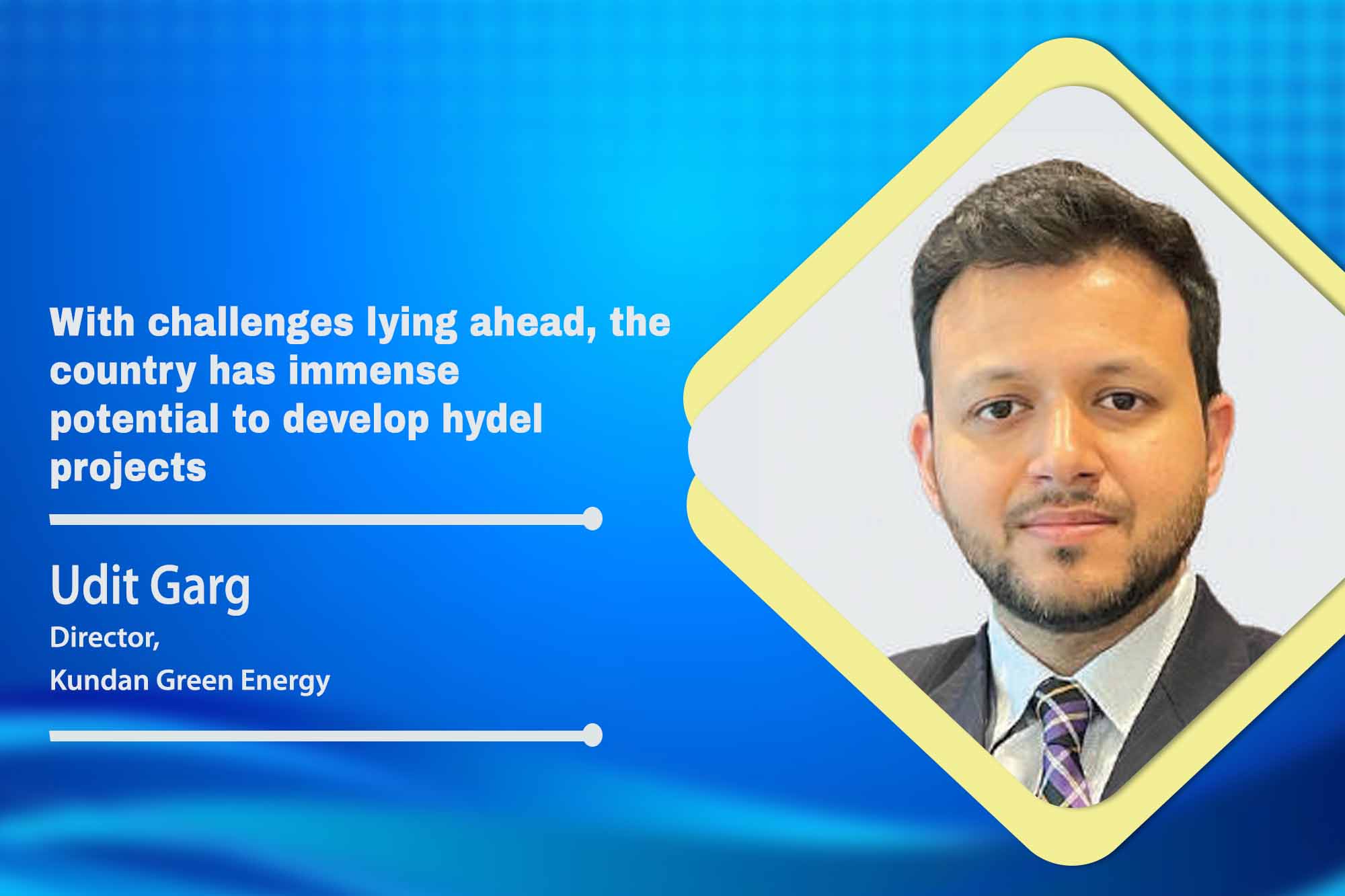Hydropower can meet the growing energy demand
By EPR Magazine Editorial March 22, 2024 6:56 pm IST
By EPR Magazine Editorial March 22, 2024 6:56 pm IST

With challenges lying ahead, the country has immense potential to develop hydel projects.
Hydroelectric power is a pivotal pillar in India’s pursuit of sustainable energy amidst global climate concerns. Despite its immense potential, the sector grapples with multifaceted challenges, ranging from financial hurdles to environmental concerns and regulatory complexities. Udit Garg speaks with EPR Magazine about the intricacies of India’s hydroelectric landscape, exploring its hurdles and opportunities in achieving a greener energy future.
How can India balance meeting its growing energy demands and preserving ecologically sensitive areas impacted by hydropower projects?
Representative of the world’s largest renewable energy source, hydropower, with its pollution-free electricity, is an essential aspect of combating climate change. As with every infrastructure project, the construction of a hydropower facility impacts communities and the environment to a degree. It is incumbent on all stakeholders, primarily the hydropower developer and operator, to maximise project benefits while minimising or mitigating any negative impacts. Hydropower must be developed sustainably.
The International Hydropower Association (IHA) has defined the good and best practices in hydropower development, represented by the Hydropower Sustainability Standard, a global certification scheme managed by the Hydropower Sustainability Alliance. This is also aligned with World Bank and IFC performance standards.
On a more granular level, one must practice essential steps like dam monitoring solutions, which help manage the safety and integrity of dams, reducing the risk of catastrophic failures while boosting operational efficiencies. As an example, among other institutionalised practices, we believe that for a structure to be truly ‘green,’ it must be planned and built with its complete life span in mind. Retrofitted and new dams must have a de-commissioning strategy, which includes a set-aside fund dedicated to restoring the river once the dam becomes obsolete.
What are the challenges hindering the growth of hydroelectric projects and the strategies to harness India’s abundant hydro-energy resources?
There are certain barriers that are hindering the growth of hydroelectric projects. Financial barriers for hydropower projects arise due to their capital-intensive nature, high upfront costs, and difficulties securing financing, often compounded by state royalties. Obtaining statutory clearances is time-consuming, involving multiple departments and causing delays. Social protests, particularly regarding resettlement and rehabilitation, lead to conflicts and uncertain public acceptance.
Water-sharing disputes, especially in regions like the Himalayas, pose significant hurdles. Environmental Impact Assessments suffer from compromised quality and lack of skilled personnel, exacerbating conflicts during public hearings. Geological uncertainties can disrupt project timelines and costs, particularly in challenging terrains. Remote project locations need more infrastructure to avoid challenges with development and labour attraction. Delays in power evacuation infrastructure development, especially in remote regions, hinder project commissioning and escalate costs. Additionally, a shortage of skilled workforce affects project execution, leading to delays and cost overruns. These challenges must be addressed with comprehensive strategies and stakeholder collaboration to foster sustainable hydroelectric development.
How are local communities benefiting from hydroelectric developments, and what measures are in place to ensure inclusive growth?Besides combating ‘energy poverty,’ at the very macro level, local communities benefit directly and almost immediately from employment, backwards and forward economy linkages, flood and drought control, irrigation support, clean drinking water, and electricity.
Given Kundan Green Energy’s collaboration, partnership and equitability practices, the firm increasingly co-opts local communities in key decision-making processes. Ensuring their access to information and benefits while respecting their interests. Participation and empowerment can improve hydropower’s social acceptability, legitimacy and overall sustainability.
How is pumped storage technology contributing to grid stability, renewable integration, and energy storage in India’s dynamic power sector?
As a best-proven and low-risk technology, it balances volatile renewable energy generation with demand. It manages grid bottlenecks while supporting grid stability by quickly responding to demand fluctuations. It stabilises the grid by contributing to grid inertia and providing black start capability. Added are the attributes of long life spans and demonstrated water resource management.
All hydropower plants, including storage, run-of-river, and pumped storage, provide immense benefits, including clean energy, base and peak load supply, quick ramp-up and ramp-down rates, black start, and operating reserve capability. In addition, pumped storage plants (PSPs) provide grid stability by acting as green and rechargeable batteries to accommodate intermittent renewables such as solar and wind.
While the expanding pumped storage capacity benefits are clear, current market structures and regulatory frameworks need to present an effective means of achieving this goal. Policy changes are needed to support the timely development of additional grid-scale energy storage.
Spokesperson: Udit Garg, Director- Kundan Green Energy
We use cookies to personalize your experience. By continuing to visit this website you agree to our Terms & Conditions, Privacy Policy and Cookie Policy.